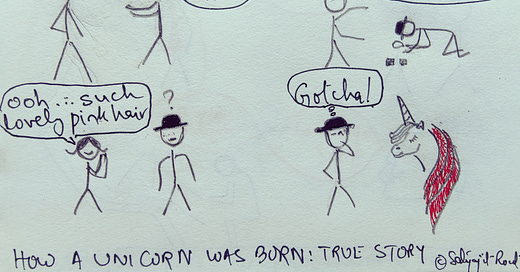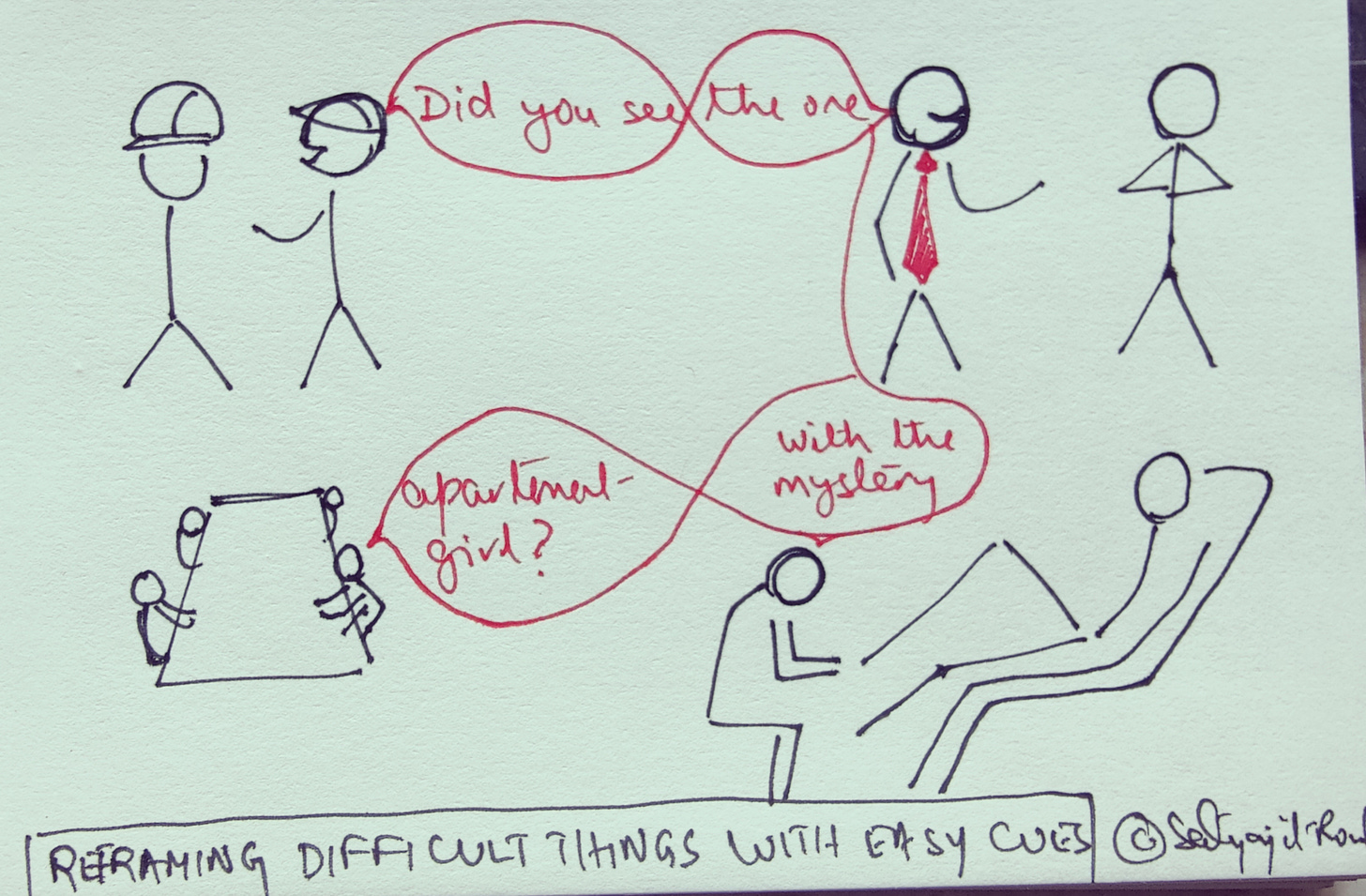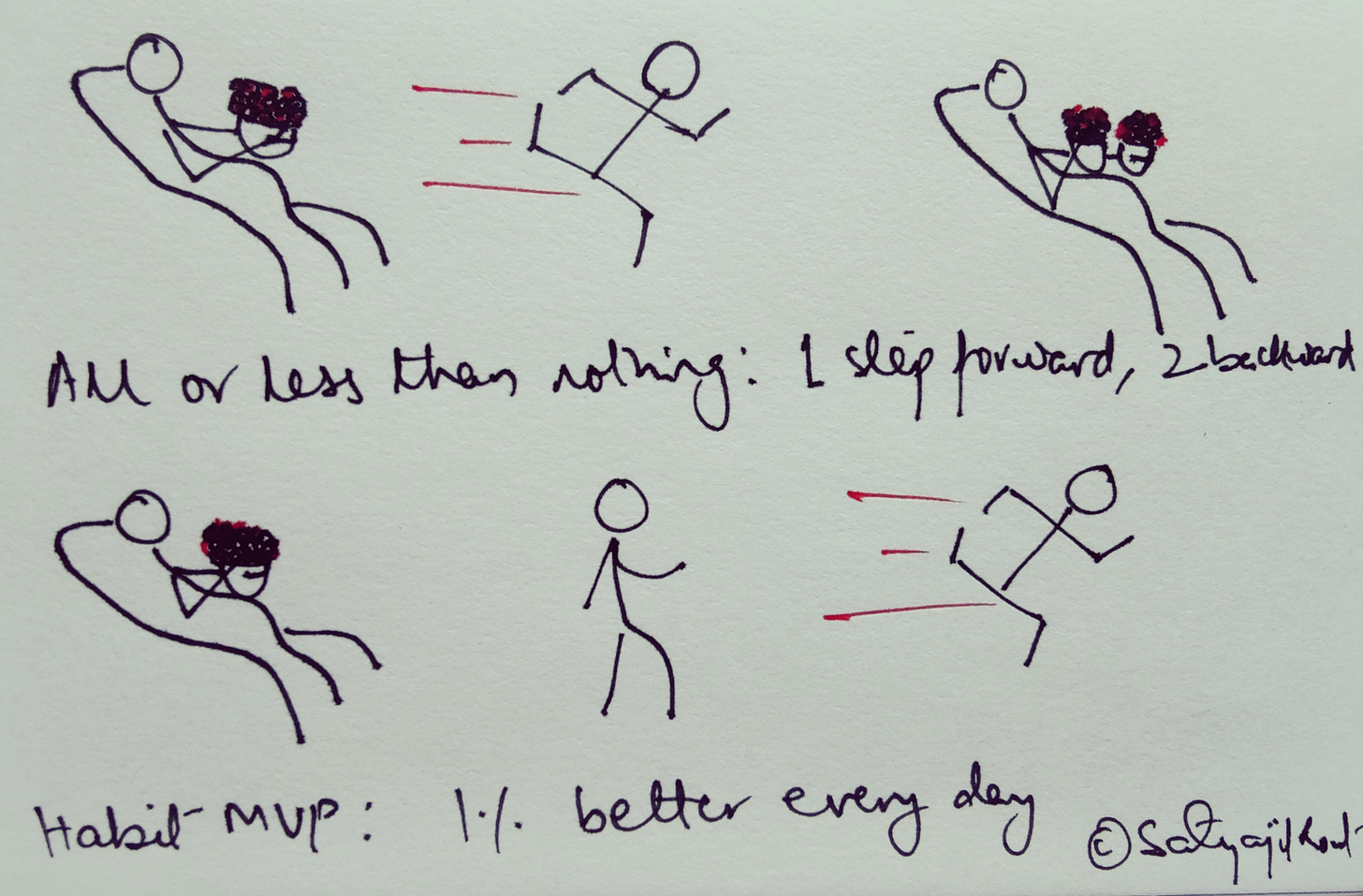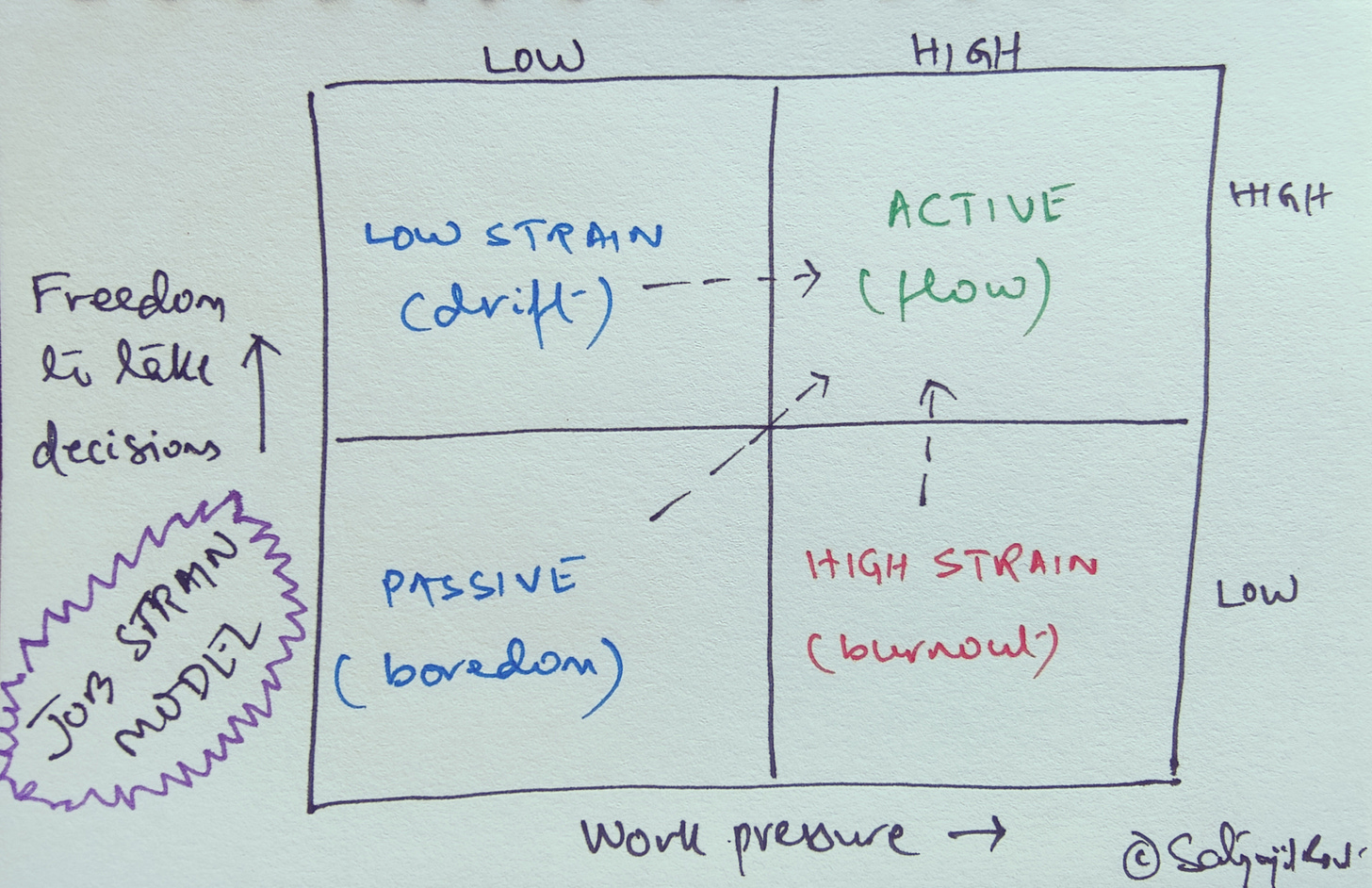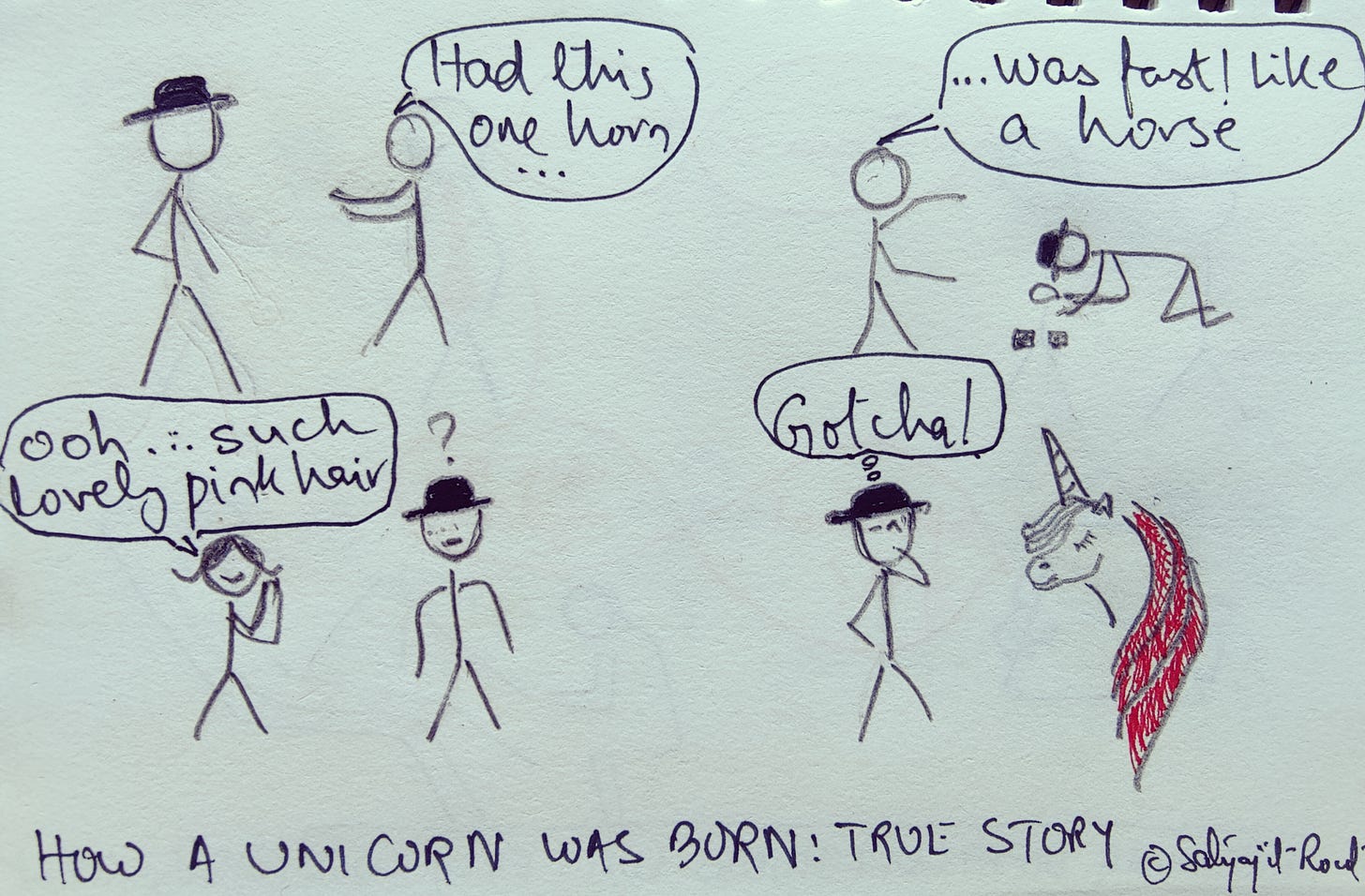#40 How TikTok reframes the making of human connection AND how to extract information like a gangsta
Motivation rituals, habit MVPs, job strain model, and more
Hi friends! 👋
Welcome to Issue #40 of Curiosity > Certainty!
Rory Sutherland, ad man, writer, and raconteur par excellence, articulates a thought that hits you in the head when you hear it. He says that pre-Daniel Kahneman (and Amos Tversky), we didn’t have a really good model for human psychology. Unlike mathematicians and physicists, psychologists and behavioral scientists lacked a latticework on which to hang their ideas (to borrow Charlie Munger’s phrase). Come to think of it, this is very true for the vast population of knowledge workers as well. While we may understand, or at least be familiar with, models of engineering and physics and chemistry, we do not have a system to organize our thoughts in matters of the human mind.
Earlier in the week, I received an invitation for an in-person roundtable event. My first thought was, Let me make sure the event's legit and there are others queuing up for it. My next thought was, I hope it’s not just for anyone and it actually has value.
It’s amazing how the contrasting mental models of social proof and scarcity can come into almost simultaneous effect. Both are levers of influence. Both work. But they are the opposite of each other. How do you decide when X is true and the opposite of X is also true? How does the human brain integrate both into one decision? And how are designers and innovators and entrepreneurs supposed to create solutions for human beings that work across situations? Praxeology is the study of human choice, action, and decision-making. I bet you didn’t know that.
I think the value of understanding consumer psychology in any professional skill is underrated. We think the world is logical when in fact it is more psycho-logical [to borrow from the book Alchemy]
This week I talk about TikTok–actually about creating a motivation ritual, which is a little strip of a routine you can paste anywhere in your day to create a powerful effect–and about, to borrow a product term, creating a habit MVP.
And then we dive deep into two tricky challenges young managers and leaders face–earning decision-making autonomy and extracting quality information.
Beat hard habits with easy motivation rituals
There’s a TikTok commercial doing the rounds. You may have seen it. It’s called Mystery Apartment Girl.
Most ads pitch you the product. They say what it is, who it is for, when it can be used. This one does none of that. None of that matters for this ad to work.
What it does better than any ad I can remember plays out in two parts.
✔#1: It brings out the why behind any habit.
The cause of habits, as James Clear says, is to satisfy basic needs. Find food, love, acceptance, certainty. These needs are common to all. They are context-independent.
The MAG commercial establishes this context-independence by answering the question: Why do humans share experiences? How it does so elevates the commercial to the status of onboarding material for aliens looking to understand us.
✔#2: It tells you no matter how you connect with fellow humans, TikTok just makes it better.
TikTok takes you from mundane to interesting. The next time you’re tongue-tied or hustling make an impression, you only need TikTok. It can get a conversation going anywhere. It provides the activation energy for a positive change to happen.
There’s something else that has a similar effect. It’s called a 𝘮𝘰𝘵𝘪𝘷𝘢𝘵𝘪𝘰𝘯 𝘳𝘪𝘵𝘶𝘢𝘭. Think of it as a pre-habit ritual that automatically gets you into a desired state of mind. It is what you associate with something enjoyable, so that whenever you do it, you slip into a state of enjoyment.
James Clear outlines a simple 3-step process:
➡𝐅𝐢𝐧𝐝 𝐬𝐨𝐦𝐞𝐭𝐡𝐢𝐧𝐠 𝐲𝐨𝐮 𝐥𝐨𝐯𝐞 𝐝𝐨𝐢𝐧𝐠: hugging your child, playing video games, sketching.
➡𝐈𝐧𝐬𝐞𝐫𝐭 𝐚 𝐬𝐡𝐨𝐫𝐭 𝐫𝐢𝐭𝐮𝐚𝐥 𝐛𝐞𝐟𝐨𝐫𝐞 𝐭𝐡𝐞 𝐡𝐚𝐩𝐩𝐲 𝐡𝐚𝐛𝐢𝐭. Take three deep breaths and smile. This creates a positive association between the ritual and the happy state.
➡𝐏𝐚𝐬𝐭𝐞 𝐭𝐡𝐚𝐭 𝐫𝐢𝐭𝐮𝐚𝐥 𝐭𝐨 𝐚𝐧𝐲 𝐩𝐚𝐫𝐭 𝐨𝐟 𝐲𝐨𝐮𝐫 𝐝𝐚𝐲 𝐭𝐨 𝐚𝐜𝐜𝐞𝐬𝐬 𝐭𝐡𝐚𝐭 𝐬𝐭𝐚𝐭𝐞 𝐨𝐟 𝐦𝐢𝐧𝐝. Now whenever you take three deep breaths and smile, your mind relaxes. The ritual becomes the cue for your brain to switch to a happy state 📈
It may sound simple. That doesn’t make it any less effective. Next time you find yourself getting into a habitual negative state, do your motivation ritual. It is your cue for feeling happy.
Just like TikTok reframes the association we have about connecting with humans (it’s exciting, not daunting!), a motivation ritual does it for a bad habit (it’s easy to beat).
You can watch the ad here.
If this piece, or my writing in general, sparked a thought in your head, I would love it if you could leave a comment telling me so.
Building a habit MVP and getting 1% better every day
Product managers and designers are obsessed with reducing friction for users. It’s not unusual to find them laboring over the smallest detail, like the placement of a text field or the number of clicks to checkout. While to the untrained eye it may seem like making a mountain out of a molehill, the golden rule for any habit-forming product is to make it easy for users.
We can apply the same rule to building good habits as well. Our only real motivation is to be lazy. We are wired to make no effort at all, if we could. So we look for the path of least resistance. Our energy-conserving selves tend to quit things that tire us.
Thankfully, there’s a hack. We require less and less effort to continue doing something. If only we could get started we can be reassured that later would be easier. That makes habit-starting the main challenge.
🔑𝐓𝐡𝐞 𝐛𝐞𝐬𝐭 𝐚𝐩𝐩𝐫𝐨𝐚𝐜𝐡 𝐭𝐨 𝐡𝐚𝐛𝐢𝐭-𝐬𝐭𝐚𝐫𝐭𝐢𝐧𝐠 𝐢𝐬 𝐭𝐨 𝐬𝐜𝐚𝐥𝐞 𝐢𝐭 𝐝𝐨𝐰𝐧. 𝐒𝐜𝐚𝐥𝐞 𝐢𝐭 𝐝𝐨𝐰𝐧 𝐭𝐨 𝐭𝐡𝐞 𝐬𝐦𝐚𝐥𝐥𝐞𝐬𝐭 𝐪𝐮𝐚𝐧𝐭𝐮𝐦 𝐨𝐟 𝐞𝐟𝐟𝐨𝐫𝐭 𝐧𝐞𝐞𝐝𝐞𝐝 𝐭𝐨 𝐬𝐭𝐚𝐫𝐭 𝐚 𝐧𝐞𝐰 𝐡𝐚𝐛𝐢𝐭.
This is what product managers do with a minimum viable product (MVP). 𝐁𝐮𝐢𝐥𝐝 𝐭𝐡𝐞 𝐬𝐦𝐚𝐥𝐥𝐞𝐬𝐭 𝐬𝐥𝐢𝐜𝐞 𝐨𝐟 𝐚 𝐩𝐫𝐨𝐝𝐮𝐜𝐭 𝐭𝐡𝐚𝐭 𝐬𝐨𝐥𝐯𝐞𝐬 𝐚 𝐫𝐞𝐚𝐥 𝐩𝐫𝐨𝐛𝐥𝐞𝐦 𝐟𝐨𝐫 𝐭𝐡𝐞 𝐜𝐮𝐬𝐭𝐨𝐦𝐞𝐫 𝐚𝐧𝐝 𝐡𝐨𝐨𝐤𝐬 𝐡𝐞𝐫 𝐟𝐨𝐫 𝐭𝐡𝐞 𝐟𝐮𝐭𝐮𝐫𝐞. Because once the customer is hooked, it is more effort for her to stop using the product than to continue using it.
You can take this concept and apply it to habit formation. Your goal is to design a habit MVP. A habit MVP is the smallest chuck of a routine that fits into yur life without disrupting it such that you can perform it repeatedly without needing motivation.
As the action becomes habitual, its scope expands as you feel less physical or cognitive load to perform it.
Just like it is a lot easier to start a running habit with 10 minutes of jogging a day and gradually ramping it up, instead of 10 miles on the first day and then nothing ever again. Anyone can become 1% better every day 🛴🚲🏍🏎
Motivation is a tax we pay to do hard things. It would be best if we didn’t have to because we’re scrooges at spending energy. A habit MVP is tax-exempt. It is built to last without motivation. That is the beauty of it.
‘As a young professional, how can I earn the freedom to make decisions?’
Early career can be a hard time. You’re hungry to create impact. But you get bogged down by micromanagement, or by having to influence without authority, or you burn yourself out in the process of trying to prove your worth.
It need not be like this. Here’s what I have learned.
Two elements, more than anything, contribute to our feeling of having made a difference and, by extension, work satisfaction. This is the ‘job strain’ model (Karasek, 1979).
☑Decision latitude, or the freedom to take work-related decisions
☑Psychological demand, or work pressure
Many early career folks believe, like I used to, that their first big success will earn them the space to make their own decisions. But earning your stripes does not automatically lead to decision latitude. Your boss, business priorities, nature of work–one or all of these may change.
It’s important then to learn to create decision-making space for yourself. Here’s a suggestion: Make your boss your ally. There are a number of reasons to do so, the most important being your boss’s success is in your success.
Framing the problem thus energizes you to find ways to make the existing arrangement work. Here are 5 ways you can go about creating decision latitude for yourself:
1️⃣ Know what is important to your boss (what’s her North Star),
2️⃣ Know how she wants accountability ('how does she prefer being updated)
3️⃣ Know what competence she takes pride in (don’t pit against her on her turf; leverage that to improve the quality of your output),
4️⃣ Tell her what kind of autonomy is important to you (the most common ways are 𝘸𝘩𝘢𝘵 𝘵𝘰 𝘥𝘰 and 𝘩𝘰𝘸 𝘵𝘰 𝘥𝘰, but what to do can be problematic*), and
5️⃣ Finally, ask better questions to break any deadlock (‘what would have to be true for us to go with the alternative?’)
A good way to kickstart this process is to make your own 𝐮𝐬𝐞𝐫 𝐦𝐚𝐧𝐮𝐚𝐥📔 where you capture all of this and more, and share it with your boss. It may even nudge her to reciprocate.
*Sometimes, you may face the inverse of this problem: 𝐲𝐨𝐮𝐫 𝐛𝐨𝐬𝐬 𝐡𝐚𝐬 𝐠𝐢𝐯𝐞𝐧 𝐲𝐨𝐮 𝐭𝐨𝐨 𝐦𝐮𝐜𝐡 𝐥𝐚𝐭𝐢𝐭𝐮𝐝𝐞 𝐚𝐧𝐝 𝐲𝐨𝐮’𝐫𝐞 𝐜𝐨𝐧𝐟𝐮𝐬𝐞𝐝 𝐚𝐛𝐨𝐮𝐭 𝐰𝐡𝐚𝐭 𝐭𝐨 𝐝𝐨. As a first-time manager I was guilty of giving autonomy without direction. This can be disorienting for young workers. The onus is on you to bring it to your manager’s notice because it is possible she’ll be, just like I was, surprised that someone wants to give up autonomy.
Piecing together the truth as a young manager
Two situations common for a young manager:
1️⃣ 𝐓𝐡𝐞 𝐦𝐨𝐫𝐞 𝐩𝐞𝐨𝐩𝐥𝐞 𝐈 𝐭𝐚𝐥𝐤 𝐭𝐨, 𝐭𝐡𝐞 𝐦𝐨𝐫𝐞 𝐜𝐨𝐧𝐟𝐮𝐬𝐞𝐝 𝐈 𝐠𝐞𝐭.
The product manager says engineering’s not sticking to timelines; the tech lead says that the specs aren’t clear; and the project manager says that their time goes setting up meetings. And oh, everyone says they’re working really hard.
If you lead a team, how do you build your own map from different viewpoints?
☑The first thing you can do is 𝐚𝐯𝐨𝐢𝐝 𝐭𝐡𝐞 𝐰𝐨𝐫𝐬𝐭 𝐨𝐮𝐭𝐜𝐨𝐦𝐞, which is to not trust your team. So, believe them when they say that they’re working their darnedest and accept that their complaints are genuine. Because they’re most likely true.
☑Then 𝐠𝐨 𝐝𝐢𝐫𝐞𝐜𝐭𝐥𝐲 𝐭𝐨 𝐭𝐡𝐞 𝐬𝐨𝐮𝐫𝐜𝐞. What you’ve with you from your reports is second-hand information, which is possibly a version of their reports’ distillations. It’s the classic map-versus-territory problem. Replace looking at the map with walking on the actual terrain.
☑Finally, 𝐚𝐬𝐤 𝐝𝐞𝐭𝐚𝐢𝐥𝐞𝐝 𝐪𝐮𝐞𝐬𝐭𝐢𝐨𝐧𝐬. Be ready to look stupid. Filter responses by motivations. The classic principal-agent problem.
These steps are hard and if there’s one outcome guaranteed at the end of it, it is that you’re now closer to reality. Accept this or you’ll be humbled time and again.
2️⃣ 𝐓𝐡𝐞 𝐦𝐨𝐫𝐞 𝐩𝐞𝐨𝐩𝐥𝐞 𝐈 𝐭𝐚𝐥𝐤 𝐭𝐨, 𝐭𝐡𝐞 𝐥𝐞𝐬𝐬 𝐈 𝐥𝐞𝐚𝐫𝐧
Clashing versions aside, 𝐬𝐨𝐦𝐞𝐭𝐢𝐦𝐞𝐬 𝐲𝐨𝐮 𝐦𝐚𝐲 𝐚𝐥𝐬𝐨 𝐠𝐞𝐭 𝐭𝐡𝐞 𝐦𝐞𝐬𝐬𝐚𝐠𝐞 𝐭𝐡𝐚𝐭 𝐞𝐯𝐞𝐫𝐲𝐭𝐡𝐢𝐧𝐠’𝐬 𝐣𝐮𝐬𝐭 𝐟𝐢𝐧𝐞. And then there’s some inevitable hiccup and the launch gets delayed or it’s a buggy release or whatever. When someone tells you that everything’s fine, understand first if they’ve thought deeply about the problem they’re trying to solve. Or if they have just regurgitated something passed on to them by their direct reports. Shit travels up too.
A way to pick this out is to 𝐝𝐫𝐢𝐯𝐞 𝐝𝐞𝐞𝐩𝐞𝐫 𝐰𝐢𝐭𝐡 𝐚 𝐬𝐞𝐫𝐢𝐞𝐬 𝐨𝐟 𝐰𝐡𝐲𝐬. Soon enough, if the person hasn’t thought enough, they’ll hit rock. If they have, they’ll just keep going.
Whether you hear multiple versions of what’s going on or the same superficial version from all, it is your job to scratch that surface. As a leader in charge of diverse business units, I don’t recall feeling confident enough in my intuition to simply pick out signs and go with my gut. I preferred to put myself through the paces, and found that it became a little easier with each try.
How do you get to the truth?
That’s it for this week. Thanks for reading!
Let me know what you made of the issue. I would be delighted to hear from you. Spread some ❤ by sharing it with a friend or two.
Until next week…

